Related Research Articles

Sir William Jones was a British philologist, orientalist and a puisne judge on the Supreme Court of Judicature at Fort William in Bengal, and a scholar of ancient India. He is particularly known for his proposition of the existence of a relationship among European and Indo-Aryan languages, which later came to be known as the Indo-European languages.

Warren Hastings was a British colonial administrator, who served as the first Governor of the Presidency of Fort William (Bengal), the head of the Supreme Council of Bengal, and so the first Governor-General of Bengal in 1772–1785. He and Robert Clive are credited with laying the foundation of the British Empire in India. He was an energetic organizer and reformer. In 1779–1784 he led forces of the East India Company against a coalition of native states and the French. Finally, the well-organized British side held its own, while France lost influence in India. In 1787, he was accused of corruption and impeached, but after a long trial acquitted in 1795. He was made a Privy Councillor in 1814.
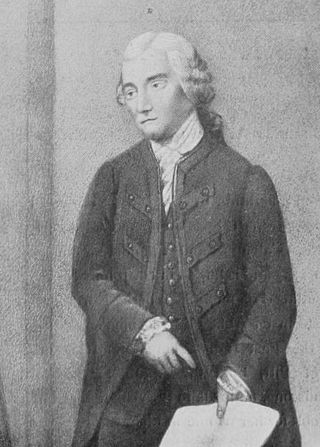
John Zephaniah Holwell was a surgeon, an employee of the British East India Company, and a temporary Governor of Bengal (1760). He was also one of the first Europeans to study Indian antiquities and was an early advocate of animal rights and vegetarianism.
Francis BuchananFRS FRSE FLS, later known as Francis Hamilton but often referred to as Francis Buchanan-Hamilton, was a Scottish physician who made significant contributions as a geographer, zoologist, and botanist while living in India. He did not assume the name of Hamilton until three years after his retirement from India.
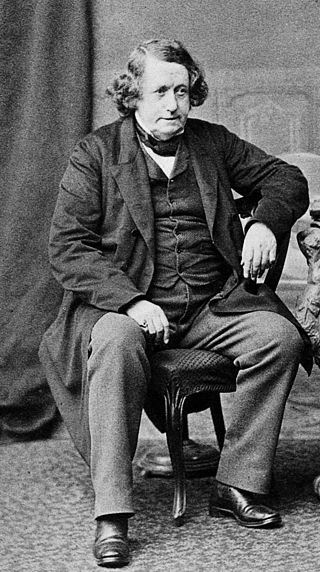
Hugh Falconer MD FRS was a Scottish geologist, botanist, palaeontologist, and paleoanthropologist. He studied the flora, fauna, and geology of India, Assam,Burma, and most of the Mediterranean islands and was the first to suggest the modern evolutionary theory of punctuated equilibrium. He studied the Siwalik fossil beds, and may also have been the first person to discover a fossil ape.
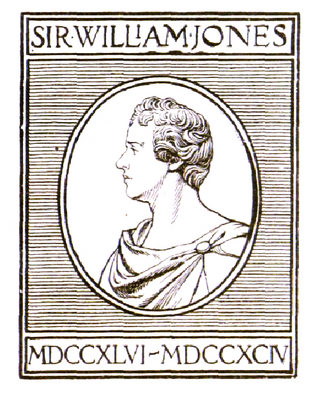
The Asiatic Society is a Government of India organisation founded during the Company rule in India to enhance and further the cause of "Oriental research". It was founded by the philologist William Jones on 15 January 1784 in a meeting presided over by Justice Robert Chambers in Calcutta, the then-capital of the Presidency of Fort William.

The Bengal Presidency, officially the Presidency of Fort William and later Bengal Province, was a subdivision of the British Empire in India. At the height of its territorial jurisdiction, it covered large parts of what is now South Asia and Southeast Asia. Bengal proper covered the ethno-linguistic region of Bengal. Calcutta, the city which grew around Fort William, was the capital of the Bengal Presidency. For many years, the Governor of Bengal was concurrently the Viceroy of India and Calcutta was the de facto capital of India until 1911.

The Bengal Renaissance, also known as the Bengali Renaissance, was a cultural, social, intellectual, and artistic movement that took place in the Bengal region of the British Raj, from the late 18th century to the early 20th century. Historians have traced the beginnings of the movement to the victory of the British East India Company at the 1757 Battle of Plassey, as well as the works of reformer Raja Rammohan Roy, considered the "Father of the Bengal Renaissance," born in 1772. Nitish Sengupta stated that the movement "can be said to have … ended with Rabindranath Tagore," Asia's first Nobel laureate.
Fort William College was an academy of oriental studies and a centre of learning, founded on 18 August 1800 by Lord Wellesley, then Governor-General of British India, located within the Fort William complex in Calcutta. Wellesley started the Fort William College to train the European administrators. He backdated the statute of foundation to 4 May 1800, to commemorate the first anniversary of his victory over Tipu Sultan at Seringapatam. Thousands of books were translated from Sanskrit, Arabic, Persian, Bengali, Hindi, and Urdu into English at this institution.

Bhashacharya Acharya Suniti Kumar Chatterjee was an Indian linguist, educationist and litterateur. He was a recipient of the second-highest Indian civilian honour of Padma Vibhushan.
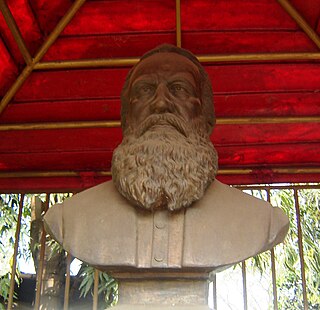
James Long (1814–1887) was an Anglo-Irish priest of the Anglican Church. A humanist, educator, evangelist, translator, essayist, philanthropist and a missionary to India, he resided in the city of Calcutta, India, from 1840 to 1872 as a member of the Church Missionary Society, leading the mission at Thakurpukur.
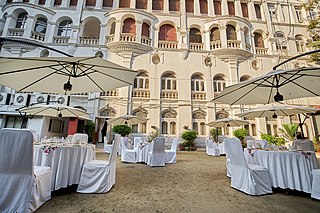
The Bengal Club is a social and business club in Kolkata, India. Founded in 1827, the club is the oldest social club in India. When Kolkata was the capital of British India, the club was considered to be the "unofficial headquarters of the Raj". The club is nowadays known for its old-world ambience and patronage among contemporary social and corporate elites, and is among a small number of Indian clubs featured in the elite list of the "Platinum Clubs of the World".
The Philadelphia Aurora was published six days a week in Philadelphia from 1794 to 1824. The paper was founded by Benjamin Franklin Bache, and was continued as a tri-weekly, after his death from yellow fever in September 1798, as a leading organ of radical republicanism by the Irish-American journalist William Duane.
The Serampore Mission Press was a book and newspaper publisher that operated in Serampore, Danish India, from 1800 to 1837.
In the last quarter of the 18th century, Calcutta grew into the first major centre of commercial and government printing. For the first time in the context of South Asia it becomes possible to talk of a nascent book trade which was full-fledged and included the operations of printers, binders, subscription publishing and libraries.
Stephen Cassan (1758–1794) was an Irish barrister in Calcutta, where he was one of the founders of the Bengal Journal. He was High Sheriff of Calcutta in 1785.

William Duane was an Irish-American republican and democrat who, as a journalist and writer, was active on four continents.
Mornington was a British merchant vessel built of teak and launched in 1799 at Calcutta. She made three voyages under charter to the British East India Company (EIC). On the first of these her non-European crew suffered a high mortality rate on the voyage back to India. On the third French privateers twice captured her and Royal Navy vessels twice recaptured her. She was a transport for the British invasion of Java in 1811. A fire destroyed her in 1815.
Shah Ardaseer was built at Bombay, probably in 1786. English transliterations of her name show her as Shah or Shaw + Adaseer, or Ardaseer, or Ardasier, or Adasier, or Ardasheer, or Ardeseer, or Ardesir. A fire on 13 September 1809 at Bombay burnt her. She then may have been recovered, repaired, and enlarged to become the hulk HMS Arrogant, which was moved to Trincomalee in 1822 and sold there in 1842.

Bibliography of early American publishers and printers is a selection of books, journals and other publications devoted to these topics covering their careers and other activities before, during and just after the American Revolution. Various works that are not primarily devoted to those topics, but whose content devotes itself to them in significant measure, are sometimes included here also. Works about Benjamin Franklin, a famous printer and publisher, among other things, are too numerous to list in this bibliography, can be found at Bibliography of Benjamin Franklin, and are generally not included here unless they are greatly devoted to Franklin's printing career. Single accounts of printers and publishers that occur in encyclopedia articles are neither included here.
References
- ↑ Nifor Guide to Indian Periodicals. National Information Service. 1955. p. 323. Retrieved 11 May 2020.
- ↑ S. K. Aggarwal (1 February 1988). Press at the crossroads in India. UDH Publishing House. p. 9. ISBN 978-81-85044-32-3 . Retrieved 11 May 2020.
- ↑ Graham Shaw (1981). Printing in Calcutta to 1800: a description and checklist of printing in late 18th-century Calcutta. Bibliographical Society. p. 8. ISBN 978-0-19-721792-4 . Retrieved 12 May 2020.
- ↑ "For India's docile media, a lesson in press freedom from 18th century Calcutta". Anu Kumar. Scroll. 15 March 2018. Retrieved 12 May 2020.
- ↑ "Bengal Journal". History of the Magazine. 2 November 2014. Retrieved 12 May 2020.
- ↑ "The English Press in Colonel India". S.M.A. Feroze. The Dawn. 22 April 2017. Retrieved 12 May 2020.
- ↑ Phillips, Kim T., "William Duane, Philadelphia's Democratic Republicans, and Origins of Modern Politics," Pennsylvania Magazine of History and Biography , Vol. 101 (1977), pp. 365–87.
- ↑ Pasley, Jeffrey L (1 January 2001). ""The tyranny of printers": newspaper politics in the early American republic". University Press of Virginia. Retrieved 9 September 2016– via Open WorldCat.
- ↑ Little, Nigel (2016). Transoceanic Radical: William Duane. New York: Routledge. pp. 117–118. ISBN 9781317314585 . Retrieved 23 May 2021.
- ↑ Shaw, Graham (1981). Printing in Calcutta to 1800: A Description and Checklist of Printing in Late 18th-century Calcutta. Bibliographical Society. p. 33. ISBN 978-0-19-721792-4.
- ↑ Clark, Allan C. (1906). "William Duane". Records of the Columbia Historical Society, Washington, D.C. 9: (14–62) 20. ISSN 0897-9049. JSTOR 40066936.